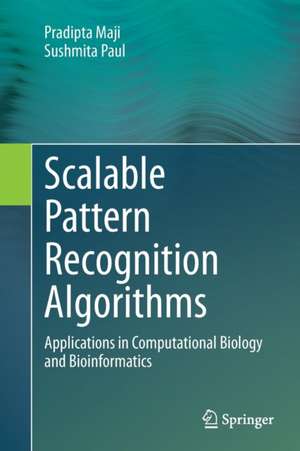Scalable Pattern Recognition Algorithms: Applications in Computational Biology and Bioinformatics
Autor Pradipta Maji, Sushmita Paulen Limba Engleză Paperback – 23 aug 2016
| Toate formatele și edițiile | Preț | Express |
|---|---|---|
| Paperback (1) | 641.85 lei 6-8 săpt. | |
| Springer International Publishing – 23 aug 2016 | 641.85 lei 6-8 săpt. | |
| Hardback (1) | 653.14 lei 6-8 săpt. | |
| Springer International Publishing – 4 apr 2014 | 653.14 lei 6-8 săpt. |
Preț: 641.85 lei
Preț vechi: 755.13 lei
-15% Nou
Puncte Express: 963
Preț estimativ în valută:
122.82€ • 131.34$ • 102.40£
122.82€ • 131.34$ • 102.40£
Carte tipărită la comandă
Livrare economică 17 aprilie-01 mai
Preluare comenzi: 021 569.72.76
Specificații
ISBN-13: 9783319379654
ISBN-10: 3319379658
Pagini: 328
Ilustrații: XXII, 304 p. 55 illus., 10 illus. in color.
Dimensiuni: 155 x 235 x 17 mm
Greutate: 0.46 kg
Ediția:Softcover reprint of the original 1st ed. 2014
Editura: Springer International Publishing
Colecția Springer
Locul publicării:Cham, Switzerland
ISBN-10: 3319379658
Pagini: 328
Ilustrații: XXII, 304 p. 55 illus., 10 illus. in color.
Dimensiuni: 155 x 235 x 17 mm
Greutate: 0.46 kg
Ediția:Softcover reprint of the original 1st ed. 2014
Editura: Springer International Publishing
Colecția Springer
Locul publicării:Cham, Switzerland
Cuprins
Introduction to Pattern Recognition and Bioinformatics.- Part I Classification.- Neural Network Tree for Identification of Splice Junction and Protein Coding Region in DNA.- Design of String Kernel to Predict Protein Functional Sites Using Kernel-Based Classifiers.- Part II Feature Selection.- Rough Sets for Selection of Molecular Descriptors to Predict Biological Activity of Molecules.- f -Information Measures for Selection of Discriminative Genes from Microarray Data.- Identification of Disease Genes Using Gene Expression and Protein-Protein Interaction Data.- Rough Sets for Insilico Identification of Differentially Expressed miRNAs.- Part III Clustering.- Grouping Functionally Similar Genes from Microarray Data Using Rough-Fuzzy Clustering.- Mutual Information Based Supervised Attribute Clustering for Microarray Sample Classification.- Possibilistic Biclustering for Discovering Value-Coherent Overlapping d -Biclusters.- Fuzzy Measures and Weighted Co-Occurrence Matrix for Segmentation of Brain MR Images.
Recenzii
From the book reviews:
“This book provides unique insights into how various soft computing and machine learning methods can be formulated and used in building efficient pattern recognition models. … This is a great resource to students and researchers in the fields of computer science, electrical and biomedical engineering. The author has explained the complex ideas through numerous examples which make conceptualization easy. … The well-organized chapters as well as use of different notations and typescripts make it a user-friendly reference.” (Parthiv Amin, Doody’s Book Reviews, August, 2014)
“This book provides unique insights into how various soft computing and machine learning methods can be formulated and used in building efficient pattern recognition models. … This is a great resource to students and researchers in the fields of computer science, electrical and biomedical engineering. The author has explained the complex ideas through numerous examples which make conceptualization easy. … The well-organized chapters as well as use of different notations and typescripts make it a user-friendly reference.” (Parthiv Amin, Doody’s Book Reviews, August, 2014)
Notă biografică
Dr. Pradipta Maji is an Associate Professor in the Machine Intelligence Unit at the Indian Statistical Institute, Kolkata, India. Dr. Sushmita Paul is a Research Associate at the same institution.
Textul de pe ultima copertă
Recent advances in high-throughput technologies have resulted in a deluge of biological information. Yet the storage, analysis, and interpretation of such multifaceted data require effective and efficient computational tools.
This unique text/reference addresses the need for a unified framework describing how soft computing and machine learning techniques can be judiciously formulated and used in building efficient pattern recognition models. The book reviews both established and cutting-edge research, following a clear structure reflecting the major phases of a pattern recognition system: classification, feature selection, and clustering. The text provides a careful balance of theory, algorithms, and applications, with a particular emphasis given to applications in computational biology and bioinformatics.
Topics and features:
This unique text/reference addresses the need for a unified framework describing how soft computing and machine learning techniques can be judiciously formulated and used in building efficient pattern recognition models. The book reviews both established and cutting-edge research, following a clear structure reflecting the major phases of a pattern recognition system: classification, feature selection, and clustering. The text provides a careful balance of theory, algorithms, and applications, with a particular emphasis given to applications in computational biology and bioinformatics.
Topics and features:
- Reviews the development of scalable pattern recognition algorithms for computational biology and bioinformatics
- Integrates different soft computing and machine learning methodologies with pattern recognition tasks
- Discusses in detail the integration of different techniques for handling uncertainties in decision-making and efficiently mining large biological datasets
- Presents a particular emphasis on real-life applications, such as microarray expression datasets and magnetic resonance images
- Includes numerous examples and experimental results to support the theoretical concepts described
- Concludes each chapter with directions for future research and a comprehensive bibliography
Caracteristici
Reviews the development of scalable pattern recognition algorithms for computational biology and bioinformatics Includes numerous examples and experimental results to support the theoretical concepts described Concludes each chapter with directions for future research and a comprehensive bibliography Includes supplementary material: sn.pub/extras

























